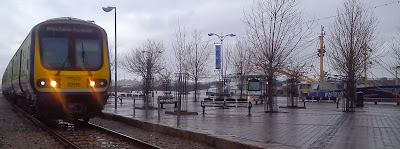Wexford Presbyterian Church, Anne Street, dates from 1840 (Photograph: Patrick Comerford, 2014)
Patrick Comerford
As I strolled down Anne Street in Wexford, from the corner with North Main Street down to the Quays, many memories came to the forefront.
I could remember how the street corner was a gathering place before lunch for many men – and they were all men in those days – who had signed on. In the 1970s, an aspiring politician complained that she had offered some of these men a day’s work and a day’s pay on her husband’s farm. But one-by-one they had turned down her offer.
The implication, of course, was that they were “gougers” and “shirkers” and that they were indigent because of their indolence. How impudent and imprudent of her. Perhaps she was hoping that their dole would be cut off in order to teach them a lesson.
But one brave unemployed man was quick to reply. He pointed out that the day’s wage being offered was only marginally higher than the meagre amount he was receiving as unemployment assistance. That margin would have been worn away by the cost of travelling out from the town to the farm, by the extra cost of living, including food and fare, and all for long hours that he would be away from his family.
In the meantime, the husband-farmer would prosper and increase his profits and the efficiency of his farm.
The aspiring politician never came back with a better offer, as far as I can remember.
The new buildings on the right-hand side of Anne Street going down the hill have totally wiped out the memory of the Shamrock Bar and the County Hotel. There were memories of the Sinnott family, Mancie Mahon – who was named in honour of the 1929 centenary of Catholic Emancipation – and fire, people, places and events that are still in memories scattered through Billy Roche’s Tumbling Down and his Wexford Trilogy.
On the left-hand side of Anne Street, the Presbyterian Church is a tribute to the survival of a community that has had a continuous presence in Wexford since the 17th century.
The Revd Robin Elliott invited me to preach in the Presbyterian churches in Wexford and Enniscorthy in 1973, when I was still only a 21-year-old. They were the first churches I ever preached in, although at the same time the late Canon Norman Ruddock had also invited me to speak at the Lenten study in his parish in Killane and Killegney.
The present church in Anne Street dates from 1840. The second minister, the Revd John Bond (1846-1849), had been ordained in the Church of Ireland, and later returned to the Church of Ireland.
In 1927, Wexford Presbyterian Church was united with Enniscorthy Presbyterian Church, which was formed in 1865. A joint Presbyterian-Methodist agreement in 1977 drew in Gorey Methodist Church and saw the closure of Wexford Methodist Church in Rowe Street.
This arrangement came to an end in June 2005, so that the churches in Wexford and Enniscorthy are now part of the Presbyterian home mission, and the church in Gorey is a Methodist church once again.
The Revd Stephen Rea was appointed to Wexford Presbyterian Church in 2006, but he has since moved to Athy, Co Kildare, and the notice board outside indicates that the church is without a minister at present.
At the end of Anne Street, I remembered how in the 1980s or 1990s there was a Greek restaurant here, adding to the international dimension of the culinary fare on offer in Wexford.
Along the Quays, the train line still follows the track that once ran alongside the former “Woodenworks.” A train was slowly and cautiously making its way through the raib along the Quays in the direction of the former South Station and on to Rosslare.
Time trundles on. Plus ça change, plus c’est la même chose.
The Rosslare train makes its way along the Quays in Wexford, slowly (Photograph: Patrick Comerford, 2014)



3 comments:
Thanks for the memories of Anne Street and the Wooden works and The County Hotel and of 1970 on wards..
When I was at Trinity I regularly preached in Wexford and Enniscorthy. The train only ran on alternative Sundays and on the non train days you had to hitch hike back which in the late 60s was quite possible.
I use to stay with the Jenkins who had a shop. Eventually I married a cousin of theirs, but totally unconnected and they had lost touch.
Brings back so many memories of the 1950s
Post a Comment